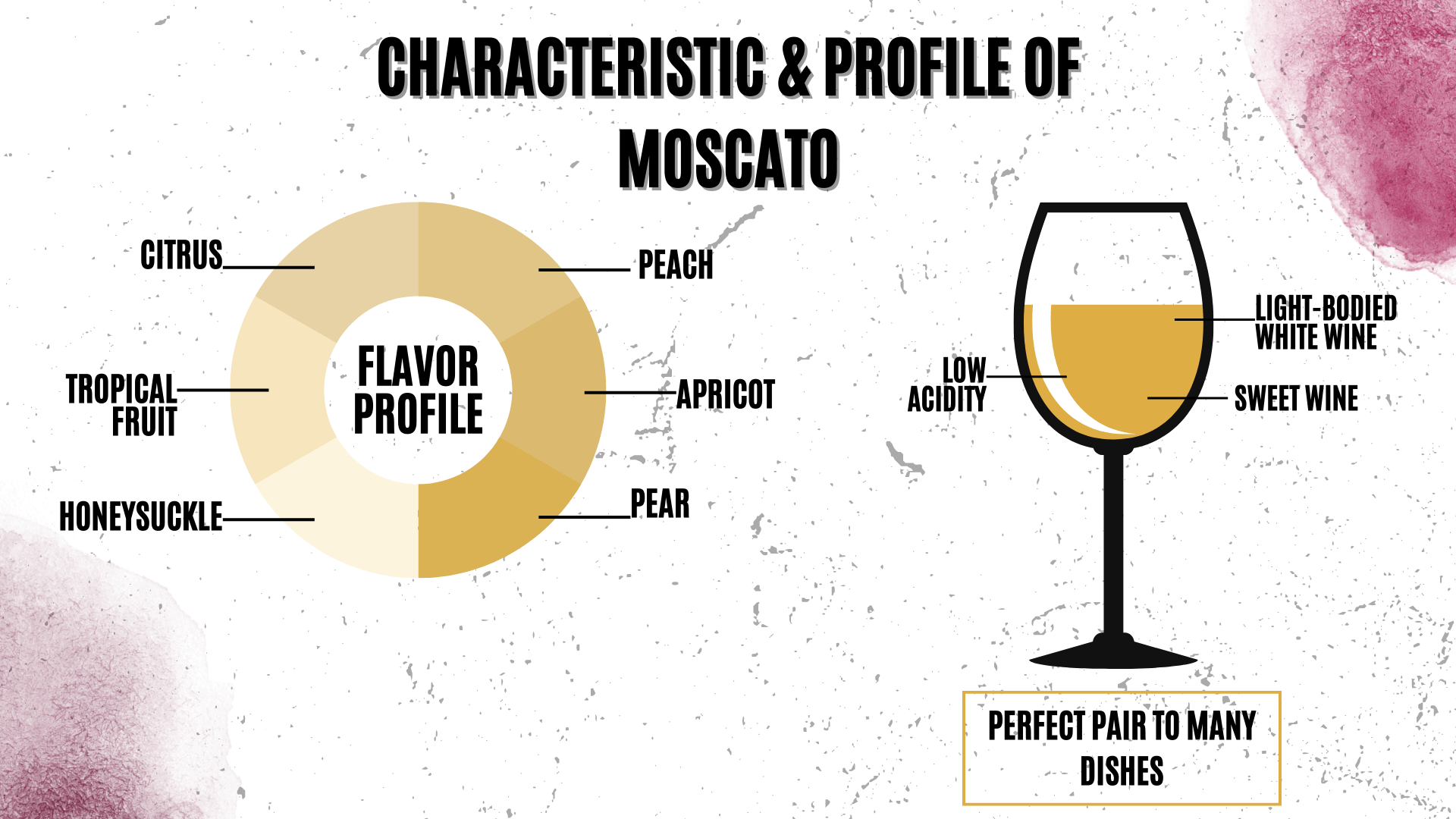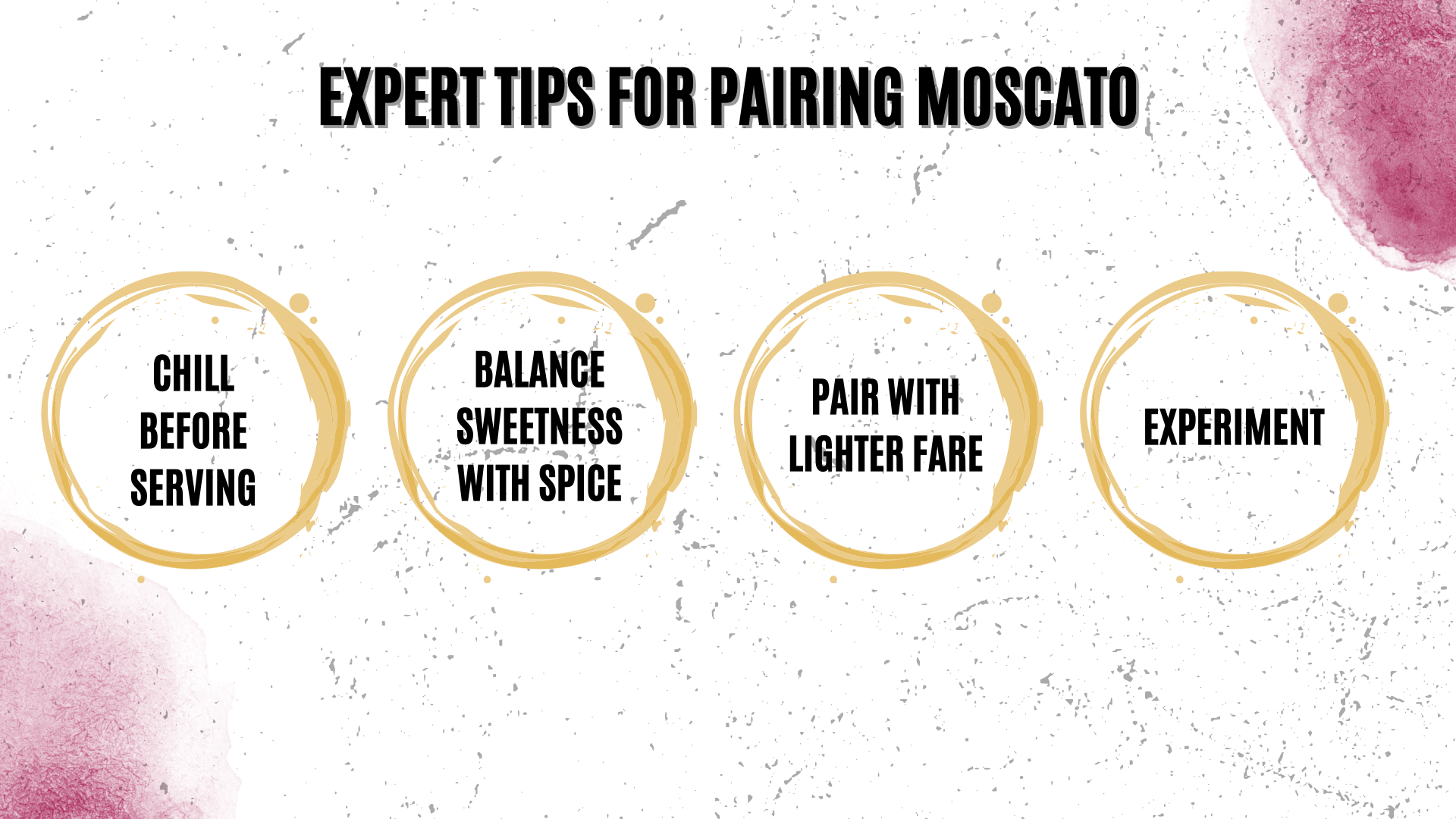Introduction
Moscato, a delightfully sweet and fragrant wine, has been enjoyed for centuries by wine enthusiasts worldwide. Made from the Muscat grape, Moscato is famous for its fruity, aromatic profile and its low alcohol content, making it a perfect choice for sipping on warm afternoons or pairing with a variety of foods. In this comprehensive guide, we’ll delve into the history and characteristics of Moscato, share expert tips, and provide both classic and creative food pairing suggestions for a delightful dining experience.

I. The History of Moscato
Moscato has a long and storied history, with its origins tracing back to ancient Greece and Rome. The Muscat grape is one of the oldest grape varieties, and its unique flavor and aroma have made it a popular choice for winemakers throughout history. Today, Moscato is produced in various wine regions worldwide, with Italy’s Piedmont region being particularly famous for its Moscato d’Asti.

II. Wine Profile
Moscato is a light-bodied, sweet, and fragrant white wine, with low to moderate acidity and a low alcohol content. Its flavor profile is typically dominated by fresh fruit flavors, such as peach, apricot, and citrus, accompanied by floral notes like orange blossom or honeysuckle. Moscato can be made in various styles, from still to sparkling and even dessert wines.
III. Characteristics of Moscato
Moscato is known for its bright, fruity, and floral aroma, which is often described as intensely perfumed. Its flavor profile is typically sweet, with notes of ripe fruit like peach, apricot, and pear, as well as hints of citrus and tropical fruit. The wine’s sweetness is balanced by its refreshing acidity, making it a delightful and easy-drinking choice.
IV. Factors to Consider for Moscato Food Pairing
- Sweetness: Moscato’s sweetness can complement or contrast various dishes, from rich, creamy desserts to spicy, savory foods.
- Acidity: The wine’s acidity can help cleanse the palate and balance the flavors of a dish, making it a versatile pairing option for different types of cuisine.
- Flavor profile: Moscato’s fruity and floral flavors can be matched with dishes featuring similar flavors, or contrasted with more savory or spicy dishes.
- Body: As a light-bodied wine, Moscato can be easily overwhelmed by heavy, rich dishes. Opt for lighter fare that won’t overpower the wine’s delicate character.
- Alcohol content: With its low alcohol content, Moscato is well-suited for daytime or casual dining, as well as for pairing with lighter, less intense dishes.
V. Classic Moscato Food Pairings
- Fruit-based desserts: Moscato’s fruity and floral flavors make it a natural choice for pairing with fruit-based desserts, such as fruit tarts, cobblers, or sorbets.
- Cheese plates: A well-curated cheese plate can be a delightful companion for Moscato, with its sweetness complementing the flavors of creamy, mild cheeses and contrasting with the saltiness of aged, hard cheeses.
- Light pastries: Moscato’s light, refreshing character makes it a perfect match for delicate pastries like cream puffs, mille-feuille, or éclairs.
- Asian cuisine: Moscato’s sweetness and acidity can balance the bold, spicy flavors often found in Asian cuisine, such as Thai, Chinese, or Indian dishes.
VI. Creative Moscato Food Pairings
- Spicy dishes: The sweetness of Moscato can help tame the heat of spicy dishes, making it an interesting and unexpected pairing for foods with a kick, like spicy Mexican dishes, buffalo wings, or spicy curries.
- Charcuterie boards: Moscato’s fruity flavors and low alcohol content can provide a refreshing contrast to the rich, savory flavors of cured meats and pâtés found on a charcuterie board.
- Seafood: While not a traditional pairing, Moscato can work well with lighter seafood dishes, like ceviche, shrimp cocktail, or a citrus-infused crab salad, where its fruity and floral flavors can complement the dish’s fresh, delicate character.
- Brunch dishes: Moscato’s low alcohol content and refreshing sweetness make it a delightful choice for pairing with brunch favorites like quiches, frittatas, or fruit salads.

VII. Expert Tips for Pairing Moscato
- Chill before serving: Moscato is best enjoyed chilled, around 45-50°F (7-10°C), to preserve its delicate flavors and refreshing character.
- Balance sweetness with spice: Moscato’s sweetness can provide a pleasant contrast to spicy dishes, helping to balance the heat and create an enjoyable dining experience.
- Pair with lighter fare: Moscato’s light body and delicate flavors can be easily overwhelmed by heavy, rich dishes. Opt for lighter fare that won’t overpower the wine’s character.
- Experiment with different styles: Moscato can be made in a variety of styles, from still to sparkling, and even dessert wines. Experiment with different styles to find the perfect Moscato pairing for your meal.
Conclusion
Moscato, with its sweet, fruity, and floral profile, is a versatile wine that can be paired with a wide range of dishes. From classic pairings with fruit-based desserts and cheese plates to more adventurous combinations with spicy dishes and seafood, Moscato offers endless possibilities for delightful food pairings. By understanding Moscato’s unique characteristics and following expert tips, you can elevate your dining experience and create memorable pairings that showcase this enchanting wine.
Frequently Asked Questions
While Moscato is most commonly associated with sweet wines, there are some dry or off-dry styles available. However, the majority of Moscato wines will have a sweet profile.
Yes, Moscato can be enjoyed as a dessert wine on its own or paired with sweet dishes. In particular, Moscato’s fruity and floral flavors make it a natural choice for pairing with fruit-based desserts.
Once opened, a bottle of Moscato should be resealed and stored in the refrigerator. It can typically be enjoyed for up to 3-5 days, depending on the specific wine and storage conditions.
Moscato is generally intended to be enjoyed young, when its fruity and floral flavors are at their most vibrant. However, some high-quality Moscatos, particularly those made in a dessert wine style, can be aged for several years.





